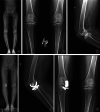Effects of Surgeon Handedness on the Outcomes of Unicompartmental Knee Arthroplasty: A Single Center's Experience
- PMID: 36281639
- PMCID: PMC9732585
- DOI: 10.1111/os.13549
Effects of Surgeon Handedness on the Outcomes of Unicompartmental Knee Arthroplasty: A Single Center's Experience
Abstract
Objective: Surgeon handedness has been widely discussed in operative surgery, and could cause clinical discrepancy. However, few studies have reported the effect of handedness on unicompartmental knee arthroplasty (UKA). Based on our clinical observation and case analysis, we aimed to find out the effects of surgeon handedness on UKA.
Methods: We retrospectively studied 94 UKA procedures performed by one right-handed surgeon from January 2017 to December 2018 at a single medical center. The cases were divided into two groups by operation side (49 L-UKAs and 45 R-UKAs). Preoperative demographic data were collected. Imaging parameters (femorotibial and hip-knee-ankle angles and tibial-plateau retroversion) and joint function scores (Knee Society Score [KSS] and Oxford Knee Score [OKS]) were recorded. Patients were followed up regularly and Forgotten Joint Score (FJS) was calculated at the last follow-up. All data were compared between the two groups with independent-samples t-test, and paired t-test was used for intragroup comparisons.
Results: The average follow-up was 26.7 ± 3.2 months. The average patient age was 63.5 ± 9.0 years and the average body mass index was 26.89 ± 3.43 kg/m2 . There was no significant group difference in any preoperative characteristic. Both the KSS and OKS improved significantly after surgery (p < 0.05). No significant group difference was found between the KSS or OKS at any follow-up visit. The varus or valgus of tibial component was 3.57 ± 1.42° on the left side and 3.19 ± 1.56° on the right side (p = 0.45). The varus or valgus of femoral component was 7.81 ± 2.43° in patients undergoing L-UKA and 7.05 ± 2.90° in those undergoing R-UKA (p = 0.04). No statistical differences were found in outliers of component orientation on both sides. The femorotibial and hip-knee-ankle angles improved significantly in both groups, and there was no significant group difference in either lower limb alignment or tibial-plateau retroversion. The complication rate was 8.16% (4/49) in the L-UKA group and 6.67% (3/45) in the R-UKA group. There was no correlation between prosthesis orientation and early joint function score.
Conclusions: Surgeon handedness may cause a worse prosthetic orientation on femoral side during surgeon's non-dominant UKA, and surgeons should be cautious of bone resection and prosthesis implantation. However, radiographic difference did not bring variations on short-term clinical outcomes or lower limb alignment.
Keywords: Clinical outcomes; Prosthesis orientation; Surgeon handedness; Unicompartmental knee arthroplasty.
© 2022 The Authors. Orthopaedic Surgery published by Tianjin Hospital and John Wiley & Sons Australia, Ltd.
Conflict of interest statement
Each author certifies that he or she has no commercial associations (e.g. consultancies, stock ownership, equity interest, patent/licensing arrangements, etc.) that might pose a conflict of interest in connection with the submitted article.
Figures

Similar articles
-
[Long-term outcome follow-up of Oxford unicompartmental knee arthroplasty for medial compartment osteoarthropathy:a single center's experience for 10 years].Zhonghua Wai Ke Za Zhi. 2022 Jul 1;60(7):703-708. doi: 10.3760/cma.j.cn112139-20220127-00039. Zhonghua Wai Ke Za Zhi. 2022. PMID: 35775264 Chinese.
-
Mild Valgus Alignment After Lateral Unicompartmental Knee Arthroplasty Led to Lower Functional Results and Survivorship at Mean 8-Year Follow-Up.J Arthroplasty. 2023 Jan;38(1):37-42. doi: 10.1016/j.arth.2022.07.009. Epub 2022 Jul 16. J Arthroplasty. 2023. PMID: 35850420
-
[Effect of surgeon's handedness on distribution of prosthesis during primary total knee arthroplasty].Zhongguo Xiu Fu Chong Jian Wai Ke Za Zhi. 2020 Jun 15;34(6):696-701. doi: 10.7507/1002-1892.201911042. Zhongguo Xiu Fu Chong Jian Wai Ke Za Zhi. 2020. PMID: 32538558 Free PMC article. Chinese.
-
Kinematic alignment of medial UKA is safe: a systematic review.Knee Surg Sports Traumatol Arthrosc. 2022 Mar;30(3):1082-1094. doi: 10.1007/s00167-021-06462-6. Epub 2021 Mar 20. Knee Surg Sports Traumatol Arthrosc. 2022. PMID: 33743031
-
Accuracy and early outcomes in medial unicompartmental knee arthroplasty performed using patient specific instrumentation.Knee. 2014;21 Suppl 1:S33-6. doi: 10.1016/S0968-0160(14)50007-5. Knee. 2014. PMID: 25382366 Review.
Cited by
-
Etiology of Total Knee Arthroplasty Revisions: A Two-Decade Institutional Perspective.Cureus. 2024 Feb 29;16(2):e55263. doi: 10.7759/cureus.55263. eCollection 2024 Feb. Cureus. 2024. PMID: 38425332 Free PMC article.
-
Head rotation and the perception of eyelid height and contour.BMJ Open Ophthalmol. 2024 Apr 4;9(1):e001557. doi: 10.1136/bmjophth-2023-001557. BMJ Open Ophthalmol. 2024. PMID: 38575344 Free PMC article.
-
Handedness and Laterality in Plastic Surgery and Outcome-A Retrospective, Two-Center, Evaluator-Blinded Study.Aesthetic Plast Surg. 2025 May;49(9):2614-2621. doi: 10.1007/s00266-025-04868-y. Epub 2025 Apr 28. Aesthetic Plast Surg. 2025. PMID: 40295368 Free PMC article.
-
Does the placement of acetabular cups differ between right and left sides for a right-handed surgeon operating through a direct lateral approach? A comparative study.Arthroplasty. 2024 Nov 5;6(1):58. doi: 10.1186/s42836-024-00278-8. Arthroplasty. 2024. PMID: 39497213 Free PMC article.
-
Surgeon handedness affects the acetabular cup positioning during primary total hip arthroplasty regardless of the surgical approach. a systematic review and metanalysis.BMC Musculoskelet Disord. 2024 Oct 7;25(1):792. doi: 10.1186/s12891-024-07868-2. BMC Musculoskelet Disord. 2024. PMID: 39375663 Free PMC article.
References
-
- Georgiev T, Angelov AK. Modifiable risk factors in knee osteoarthritis: treatment implications. Rheumatol Int. 2019;39(7):1145–57. - PubMed
-
- Pollo FE, Otis JC, Backus SI, Warren RF, Wickiewicz TL. Reduction of medial compartment loads with valgus bracing of the osteoarthritic knee. Am J Sports Med. 2002;30(3):414–21. - PubMed
-
- Weber M, Völlner F, Benditz A, Schwarz T, Wörner M, Craiovan B, et al. Total knee arthroplasty in the elderly. Orthopade. 2017;46(1):34–9. - PubMed
-
- Liebensteiner M, Köglberger P, Ruzicka A, Giesinger JM, Oberaigner W, Krismer M. Unicondylar vs. total knee arthroplasty in medial osteoarthritis: a retrospective analysis of registry data and functional outcome. Arch Orthop Trauma Surg. 2020;140(4):545–9. - PubMed
-
- Kayani B, Konan S, Tahmassebi J, Rowan FE, Haddad FS. An assessment of early functional rehabilitation and hospital discharge in conventional versus robotic‐arm assisted unicompartmental knee arthroplasty: a prospective cohort study. Bone Joint J. 2019;101‐B(1):24–33. - PubMed
MeSH terms
Grants and funding
LinkOut - more resources
Full Text Sources
Medical

